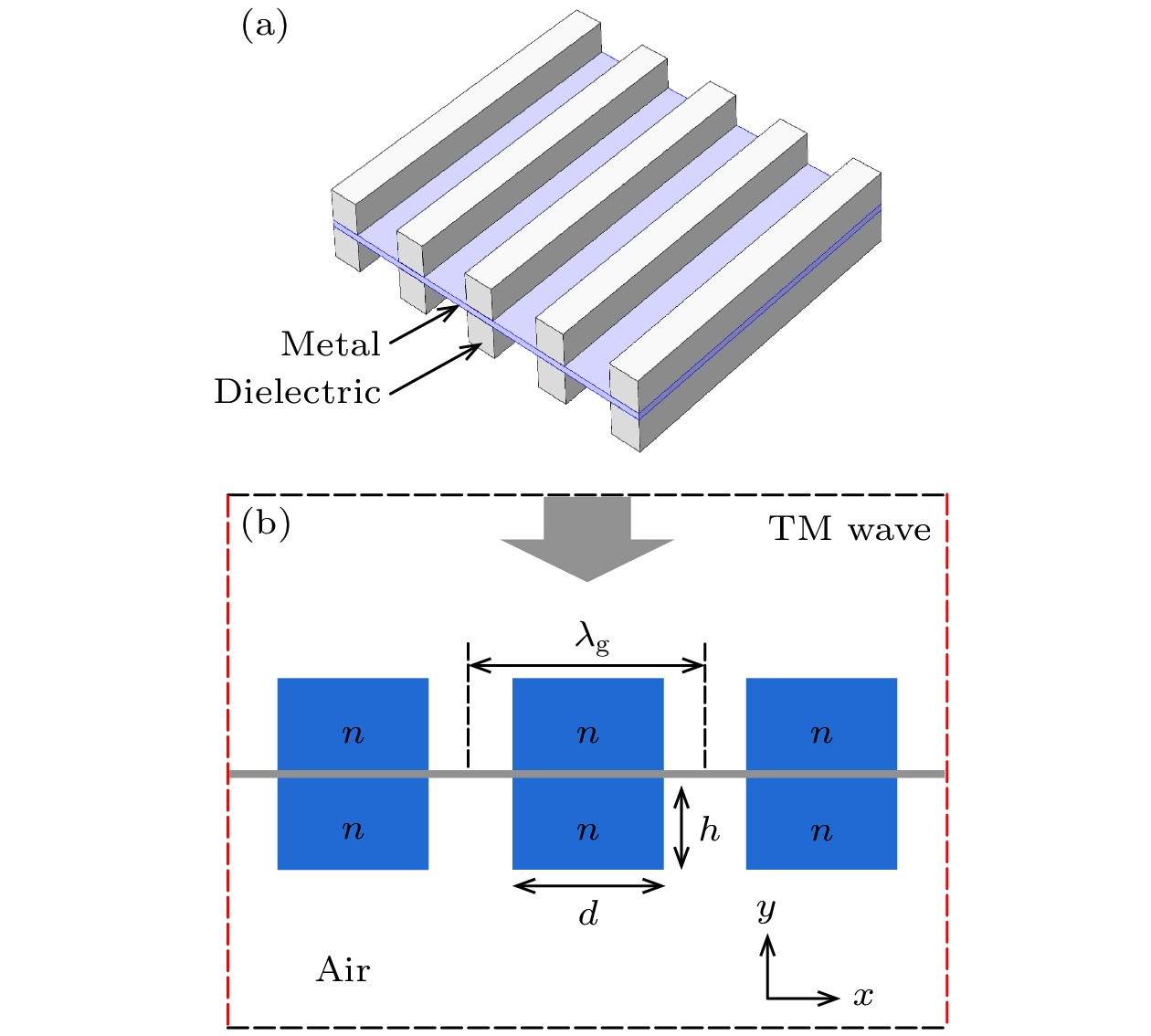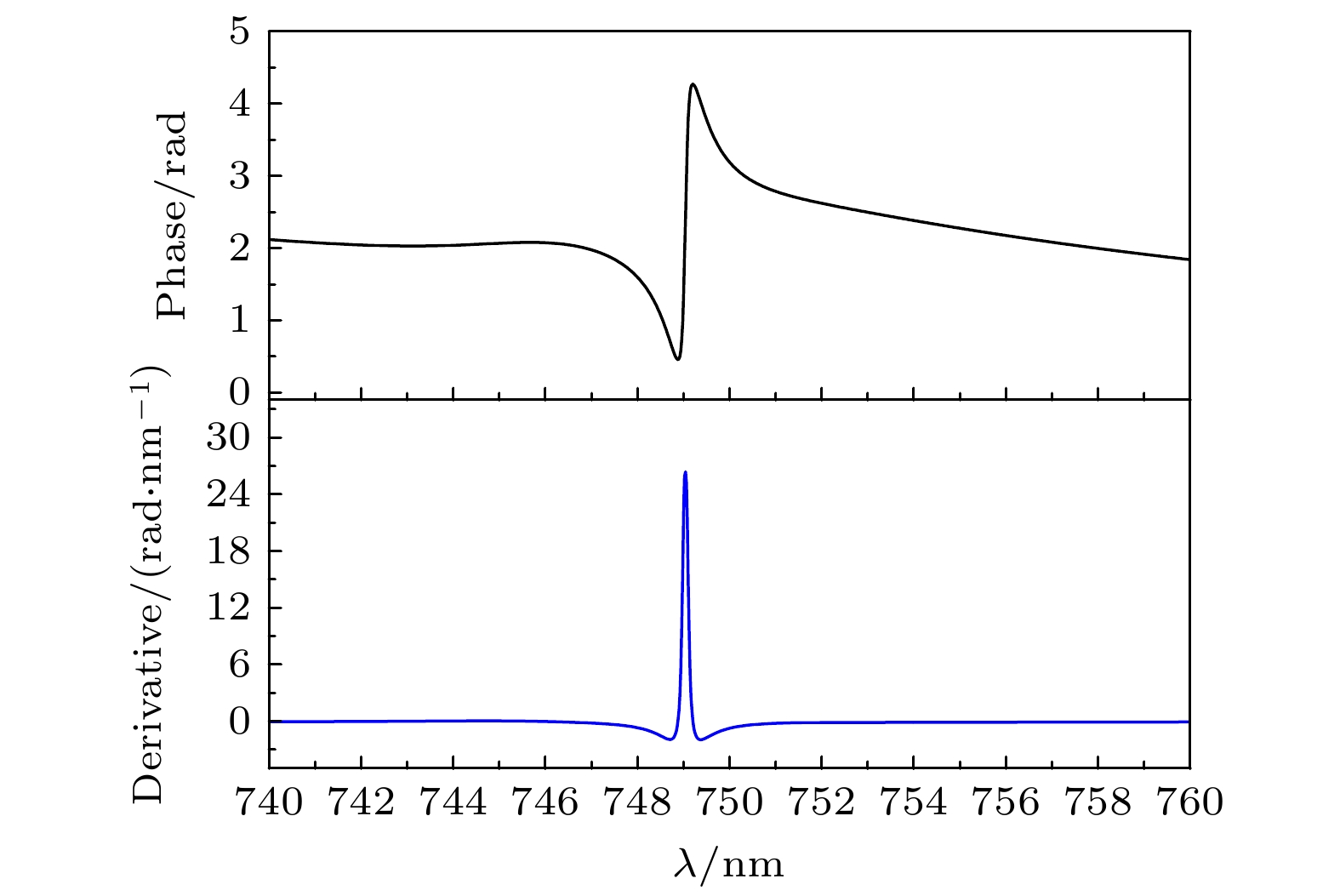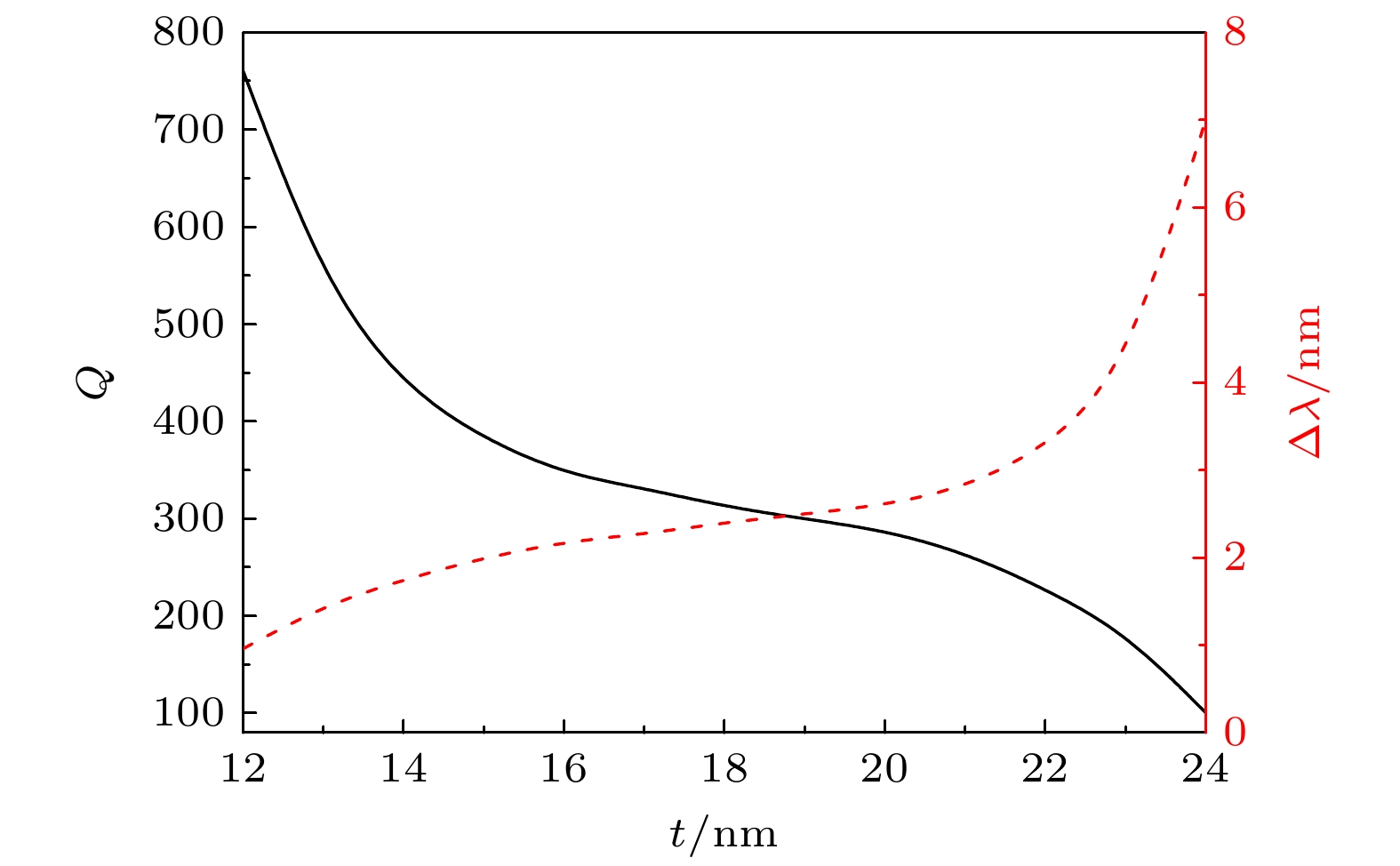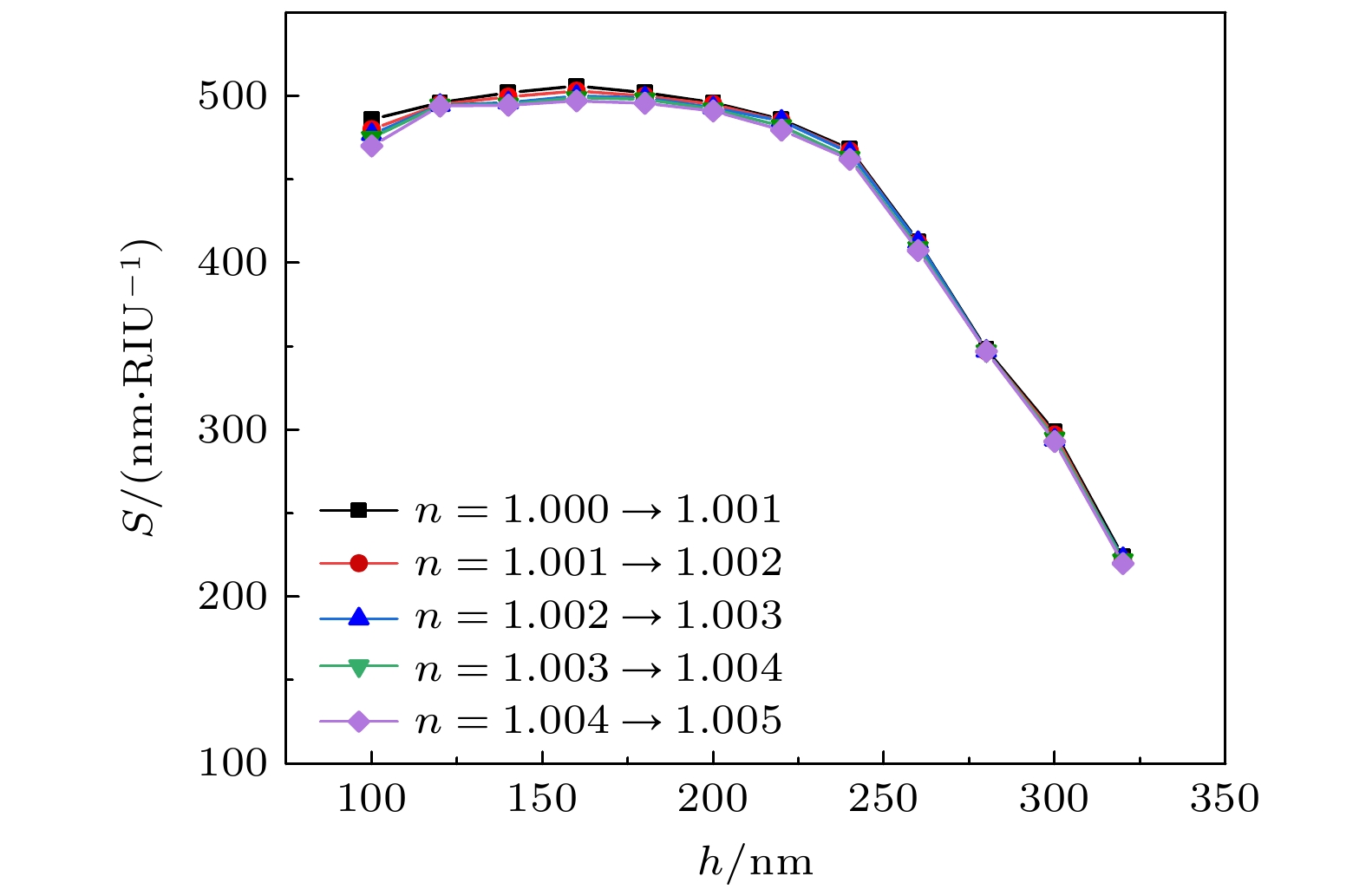-
提出一种在连续金属膜两侧放置对称介质光栅来实现完美吸收的方案. 在银膜厚度为20 nm, 晶格常数为400 nm, 介质折射率为1.46的情况下, 得到最大吸收系数为99.47%. 此时, 吸收谱的线宽为2.53 nm, 品质因子Q为296.06. 研究发现, 在完美吸收时, 入射光的反射和透射受到有效抑制, 吸收系数的相位梯度达到最大. 完美吸收由长程表面等离子激元(LRSPP)决定, 它的电场主要分布在银膜的外侧并形成驻波状, 传输损失很小. 当银膜厚度减小时, 吸收谱线的线宽逐渐减少, 而Q值增大. 当厚度降到12 nm左右时, 得到最小线宽0.98 nm和最大Q值760.0左右. 完美吸收时的锐利吸收曲线和较高的品质因子可用于高灵敏度的微纳米传感器的设计与应用.The perfect absorption is achieved by the structure of a continuous metal film with symmetrical grating structure on both sides. The maximum absorption coefficient can reach 99.47% for a optimal structural parameters with a silver film thickness of 20 nm, a lattice constant of 400 nm, and a medium refractive index of 1.46. The full width of half maximum of the absorption line is about 2.53 nm, and the quality factor Q is 296.06. When the absorption is perfect, the reflection and transmission of the incident light are effectively suppressed, and the phase gradient of the absorption coefficient reaches a maximum value. The perfect absorption is determined by the long-range surface plasma polariton (LRSPP) with a little transmission loss, long propagation distance and deep penetration depth. And the electric field is mainly distributed outside the silver film with a standing wave distribution. As the thickness of the silver film decreases, the line width of the absorption spectrum gradually decreases, while the Q value and electric field strength increase. When the thickness drops to about 12 nm, the minimum line width is 0.98 nm and the maximum Q value is 760.0. The sharp absorption curve and very high quality factor at the perfect absorption can be used in the design and application of the highly sensitive micro-nano sensor.
[1] Ritchie R H 1957 Phys. Rev. 106 874
 Google Scholar
Google Scholar
[2] Barnes W L, Dereux A, Ebbesen T W 2003 Nature 424 824
 Google Scholar
Google Scholar
[3] Wang Z L 2009 Prog. Phys. 29 287
[4] Sarid D 1981 Phys. Rev. Lett. 47 1927
 Google Scholar
Google Scholar
[5] Bozhevolnyi S I, Volkov V S, Devaux E, Laluet J Y, Ebbesen T W 2006 Nature 440 508
 Google Scholar
Google Scholar
[6] Berini P 2009 Adv. Opt. Photonics 1 484
 Google Scholar
Google Scholar
[7] Berini P 2000 Opt. Express 7 329
 Google Scholar
Google Scholar
[8] Wong W R, Berini P 2019 Opt. Express 27 25470
 Google Scholar
Google Scholar
[9] Fuentes-Fuentes M A, May-Arrioja D A, Guzman-Sepulveda J R, Arteaga-Sierra F, Torres-Cisneros M, Likamwa P L, Sánchez-Mondragón J J 2019 Opt. Express 27 8858
 Google Scholar
Google Scholar
[10] Xu Y, Wang F, Gao Y, Zhang D, Sun X, Berini P 2020 Sensors 20 2507
 Google Scholar
Google Scholar
[11] Chen X I, Wenyi B U, Wu Z, Zhang H, Pu J 2021 Opt. Express 29 16455
 Google Scholar
Google Scholar
[12] Zakaria R, Zainuddin N, Fahri M, Thirunavakkarasu P M, Harun S W 2021 Opt. Fiber Technol. 61 102449
 Google Scholar
Google Scholar
[13] Hooper I R, Sambles J R 2004 Phys. Rev. B 70 045421
 Google Scholar
Google Scholar
[14] Sukharev M, Sievert P R, Seideman T, Ketterson J B 2009 J. Chem. Phys. 131 034708
 Google Scholar
Google Scholar
[15] Mu W, Buchholz D B, Sukharev M, Jang J I, Chang R P H, Ketterson J B 2010 Opt. Lett. 35 550
 Google Scholar
Google Scholar
[16] Mu W, Ketterson J B 2011 Opt. Lett. 36 4713
 Google Scholar
Google Scholar
[17] Abutoama M, Abdulhalim I 2015 Opt. Express 23 28667
 Google Scholar
Google Scholar
[18] Abutoama M, Abdulhalim I 2016 IEEE J. Sel. Top. Quant. 23 72
[19] 张凯, 杜春光, 高健存 2017 66 227302
 Google Scholar
Google Scholar
Zhang K, Du C G, Gao J C 2017 Acta Phys. Sin. 66 227302
 Google Scholar
Google Scholar
[20] Zeng L W, Chen M, Yan W, Li Z F, Yan F H 2020 Opt. Commun. 457 124641
 Google Scholar
Google Scholar
[21] Joseph S, Sarkar S, Joseph J 2020 ACS Appl. Mater. Interfaces 12 46519
 Google Scholar
Google Scholar
[22] Wang Z L, Li S Q, Chang R P H, Ketterson J B 2014 J. Appl. Phys. 116 033103
 Google Scholar
Google Scholar
[23] 薛润玉, 王正宇, 王正岭 2022 光学学报 42 228
Xue R Y, Wang Z Y, Wang Z L 2022 Acta Opt. Sin. 42 228
[24] Ebbesen T W, Lezec H J, Ghaemi H F, Thio T, Wolff P A 1998 Nature 391 667
 Google Scholar
Google Scholar
-
图 7 当h = 172.4 nm, d = 350.0 nm,
$ {\lambda _0} $ = 550.0 nm时, LRSPP的电场Ey在x-y平面上分布 (a) Ey在x-y平面上的二维分布; (b) 在x = 100 nm处, Ey在y方向上的分布Fig. 7. The distribution of Ey of LRSPP in the x-y plane as h = 172.4 nm, d = 350.0 nm,
$ {\lambda _0} $ = 550.0 nm: (a) 2D distribution of Ey in the x-y plane; (b) the distribution of Ey in the y direction as x = 100 nm.图 8 当h = 172.4 nm, d = 350.0 nm,
$ {\lambda _0} $ = 725.0 nm时, SRSPP的电场Ey在x-y平面上分布 (a) Ey在x-y平面上的二维分布; (b) 在x = –110 nm处, Ey在y方向上的分布Fig. 8. The distribution of Ey of SRSPP in the x-y plane as h = 172.4 nm, d = 350.0 nm,
$ {\lambda _0} $ = 725.0 nm: (a) 2D distribution of Ey in the x-y plane ; (b) the distribution of Ey in the y direction as x = –110 nm. -
[1] Ritchie R H 1957 Phys. Rev. 106 874
 Google Scholar
Google Scholar
[2] Barnes W L, Dereux A, Ebbesen T W 2003 Nature 424 824
 Google Scholar
Google Scholar
[3] Wang Z L 2009 Prog. Phys. 29 287
[4] Sarid D 1981 Phys. Rev. Lett. 47 1927
 Google Scholar
Google Scholar
[5] Bozhevolnyi S I, Volkov V S, Devaux E, Laluet J Y, Ebbesen T W 2006 Nature 440 508
 Google Scholar
Google Scholar
[6] Berini P 2009 Adv. Opt. Photonics 1 484
 Google Scholar
Google Scholar
[7] Berini P 2000 Opt. Express 7 329
 Google Scholar
Google Scholar
[8] Wong W R, Berini P 2019 Opt. Express 27 25470
 Google Scholar
Google Scholar
[9] Fuentes-Fuentes M A, May-Arrioja D A, Guzman-Sepulveda J R, Arteaga-Sierra F, Torres-Cisneros M, Likamwa P L, Sánchez-Mondragón J J 2019 Opt. Express 27 8858
 Google Scholar
Google Scholar
[10] Xu Y, Wang F, Gao Y, Zhang D, Sun X, Berini P 2020 Sensors 20 2507
 Google Scholar
Google Scholar
[11] Chen X I, Wenyi B U, Wu Z, Zhang H, Pu J 2021 Opt. Express 29 16455
 Google Scholar
Google Scholar
[12] Zakaria R, Zainuddin N, Fahri M, Thirunavakkarasu P M, Harun S W 2021 Opt. Fiber Technol. 61 102449
 Google Scholar
Google Scholar
[13] Hooper I R, Sambles J R 2004 Phys. Rev. B 70 045421
 Google Scholar
Google Scholar
[14] Sukharev M, Sievert P R, Seideman T, Ketterson J B 2009 J. Chem. Phys. 131 034708
 Google Scholar
Google Scholar
[15] Mu W, Buchholz D B, Sukharev M, Jang J I, Chang R P H, Ketterson J B 2010 Opt. Lett. 35 550
 Google Scholar
Google Scholar
[16] Mu W, Ketterson J B 2011 Opt. Lett. 36 4713
 Google Scholar
Google Scholar
[17] Abutoama M, Abdulhalim I 2015 Opt. Express 23 28667
 Google Scholar
Google Scholar
[18] Abutoama M, Abdulhalim I 2016 IEEE J. Sel. Top. Quant. 23 72
[19] 张凯, 杜春光, 高健存 2017 66 227302
 Google Scholar
Google Scholar
Zhang K, Du C G, Gao J C 2017 Acta Phys. Sin. 66 227302
 Google Scholar
Google Scholar
[20] Zeng L W, Chen M, Yan W, Li Z F, Yan F H 2020 Opt. Commun. 457 124641
 Google Scholar
Google Scholar
[21] Joseph S, Sarkar S, Joseph J 2020 ACS Appl. Mater. Interfaces 12 46519
 Google Scholar
Google Scholar
[22] Wang Z L, Li S Q, Chang R P H, Ketterson J B 2014 J. Appl. Phys. 116 033103
 Google Scholar
Google Scholar
[23] 薛润玉, 王正宇, 王正岭 2022 光学学报 42 228
Xue R Y, Wang Z Y, Wang Z L 2022 Acta Opt. Sin. 42 228
[24] Ebbesen T W, Lezec H J, Ghaemi H F, Thio T, Wolff P A 1998 Nature 391 667
 Google Scholar
Google Scholar
计量
- 文章访问数: 5773
- PDF下载量: 91
- 被引次数: 0














 下载:
下载:


















